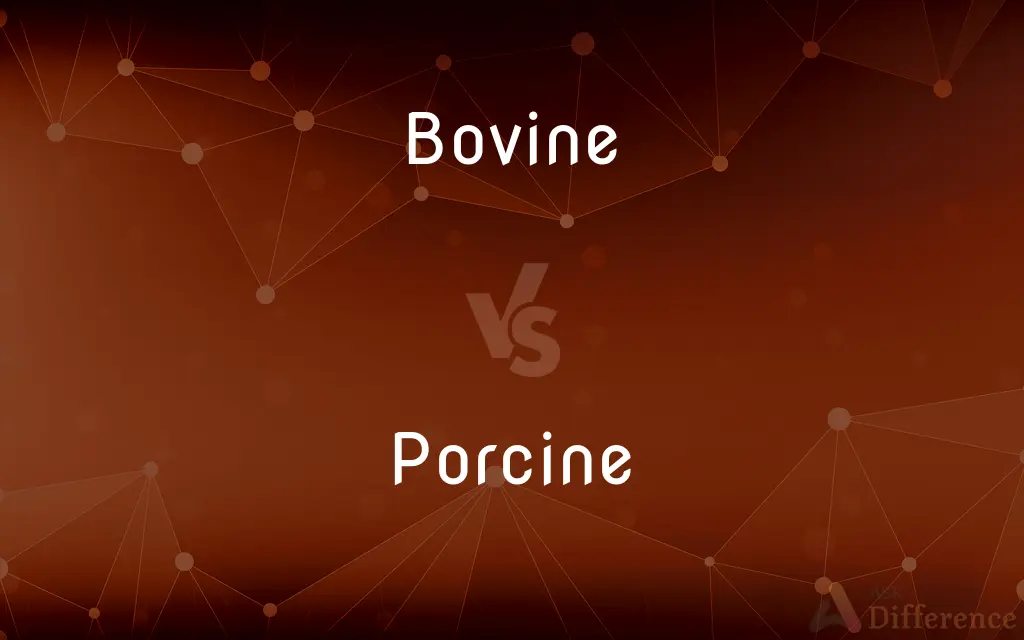Bovine vs. Porcine — What's the Difference?
By Urooj Arif & Maham Liaqat — Updated on May 1, 2024
Bovine refers to cattle-related species, commonly associated with farming and dairy, while porcine pertains to pigs, often linked to meat production and biomedical research.

Difference Between Bovine and Porcine
Table of Contents
ADVERTISEMENT
Key Differences
Bovine animals, such as cows and bulls, are primarily raised for dairy products and beef, which are staples in many diets worldwide. In contrast, porcine animals, like pigs, are valued for their pork and play a crucial role in culinary traditions across various cultures.
Bovine species are often involved in large-scale dairy operations, producing milk, cheese, and butter. Whereas porcine species are not used for milk production but are renowned for their efficiency in converting feed into body mass, making them key in meat production.
In terms of size and lifespan, bovine animals tend to be larger and live longer than porcine animals. Pigs, on the other hand, are generally smaller and have shorter lifespans, which influences their farming cycles and economic value.
Bovine genetics have been extensively studied to improve traits like milk yield and meat quality. Porcine genetics, however, have been equally researched, particularly for their relevance to human medicine, including organ transplants and genetic studies.
Environmentally, bovine farming has a significant impact due to methane production and land use for grazing. Porcine farming, while still impactful, often requires less space and can contribute to different environmental concerns, such as waste management and nutrient runoff.
ADVERTISEMENT
Comparison Chart
Primary Use
Dairy products and beef
Pork and medical research
Production Focus
Milk, cheese, butter
Efficient meat production
Size and Lifespan
Larger and longer-lived
Smaller and shorter-lived
Genetic Research
Milk yield and meat quality
Organ compatibility and diseases
Environmental Impact
Methane production, large grazing areas
Less grazing, issues with waste management
Compare with Definitions
Bovine
Slow or dull.
His bovine expression made him seem uninterested.
Porcine
Resembling a pig in behavior or appearance.
His porcine snort was unmistakable during laughter.
Bovine
Resembling a cow or ox.
The statue had a distinctly bovine appearance.
Porcine
Pertaining to pigs.
Porcine diets are formulated to maximize growth.
Bovine
Relating to cattle.
Bovine animals are commonly found on dairy farms.
Porcine
Connected to pig farming.
Porcine production is critical in many agricultural economies.
Bovine
Pertaining to cows and bulls.
Bovine veterinary medicine focuses on cattle health.
Porcine
Relating to swine.
Porcine flu can affect swine populations severely.
Bovine
Connected to bovine species.
Bovine leather is widely used in manufacturing.
Porcine
Used in medical research.
Porcine heart valves are used in human surgeries.
Bovine
Of, relating to, or resembling a ruminant mammal of the bovid subfamily Bovinae, such as a cow, ox, or buffalo, especially one in the genus Bos.
Porcine
Of or resembling swine or a pig
"a bald porcine old man" (Vladimir Nabokov).
Bovine
Sluggish, dull, and stolid.
Porcine
Of or pertaining to pigs.
Bovine
An animal of the subfamily Bovinae, especially one of the genus Bos.
Porcine
(derogatory) Overweight to the extent of resembling a pig; morbidly obese.
Bovine
(not comparable) Of or pertaining to cattle.
Porcine
Of or pertaining to swine; characteristic of the hog.
Bovine
(not comparable) Belonging to the family, subfamily, tribe, or genera including cows, buffalo, and bison.
Porcine
Relating to or suggesting swine;
Comparison between human and porcine pleasures
Bovine
Sluggish, dull, slow-witted.
Porcine
Repellently fat;
A bald porcine old man
Bovine
An animal of the family, subfamily, tribe, or genera including cattle, buffaloes and bison.
Porcine
Resembling swine; coarsely gluttonous or greedy;
Piggish table manners
The piggy fat-cheeked little boy and his porcine pot-bellied father
Swinish slavering over food
Bovine
Of or pertaining to the genus Bos; relating to, or resembling, the ox or cow; oxlike; as, the bovine genus; a bovine antelope.
Bovine
Having qualities characteristic of oxen or cows; sluggish and patient; dull; as, a bovine temperament.
The bovine gaze of gaping rustics.
Bovine
Any of various members of the genus Bos
Bovine
Of or relating to or belonging to the genus Bos (cattle)
Bovine
Dull and slow-moving and stolid; like an ox;
Showed a bovine apathy
Common Curiosities
What are typical products derived from bovine animals?
Bovine products include milk, cheese, butter, and beef.
What are typical products derived from porcine animals?
Porcine products mainly include various types of pork.
What are common diseases affecting bovine and porcine animals?
Bovine animals often deal with diseases like Bovine Spongiform Encephalopathy, while porcine animals are susceptible to swine flu.
What roles do bovine and porcine animals play in genetics research?
Bovine genetics are studied for agricultural improvements, while porcine genetics are often studied for medical applications.
How do bovine and porcine animals differ in farming practices?
Bovine farming often involves extensive grazing, whereas porcine farming is more confined and intensive.
What is the lifespan of bovine versus porcine animals?
Bovine animals typically live up to 20 years, while porcine animals have a shorter lifespan of about 10-15 years.
Can both bovine and porcine be used in leather production?
Yes, both types of animals are used, but bovine leather is more common and widely utilized.
How do bovine and porcine compare in terms of intelligence?
Pigs are considered highly intelligent, often more so than cattle.
How do bovine and porcine animals contribute to human food consumption?
Bovine animals contribute dairy and beef, while porcine animals are primarily a source of pork.
How are bovine and porcine animals used in biomedical fields?
Bovine tissues are used in pharmaceuticals, whereas porcine organs are significant in transplant research.
Which has a larger environmental impact: bovine or porcine farming?
Bovine farming generally has a larger environmental footprint, particularly in terms of methane emissions and land use.
What global regions predominantly farm bovine versus porcine animals?
Bovine farming is prevalent in regions like North America and Europe, while porcine farming is significant in Asia and parts of Europe.
What is the difference in growth rates between bovine and porcine animals?
Porcine animals grow faster and are slaughtered younger compared to bovine animals.
What are the dietary differences between bovine and porcine animals?
Bovine animals are primarily grazers, while porcine animals are omnivorous and more versatile in their diets.
What are some cultural significances of bovine and porcine animals?
Bovine animals are sacred in some cultures, whereas porcine animals are avoided in others due to religious restrictions.
Share Your Discovery

Previous Comparison
Familiar vs. Proficient
Next Comparison
Core vs. BaseAuthor Spotlight
Written by
Urooj ArifUrooj is a skilled content writer at Ask Difference, known for her exceptional ability to simplify complex topics into engaging and informative content. With a passion for research and a flair for clear, concise writing, she consistently delivers articles that resonate with our diverse audience.
Co-written by
Maham Liaqat















































